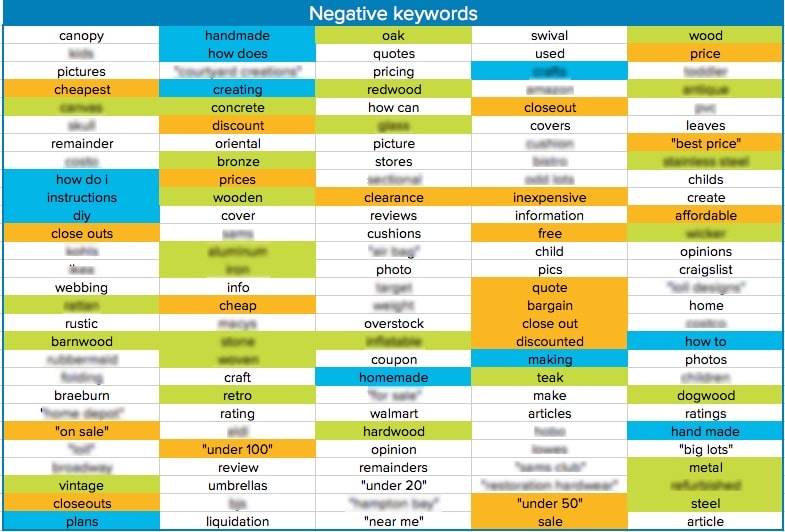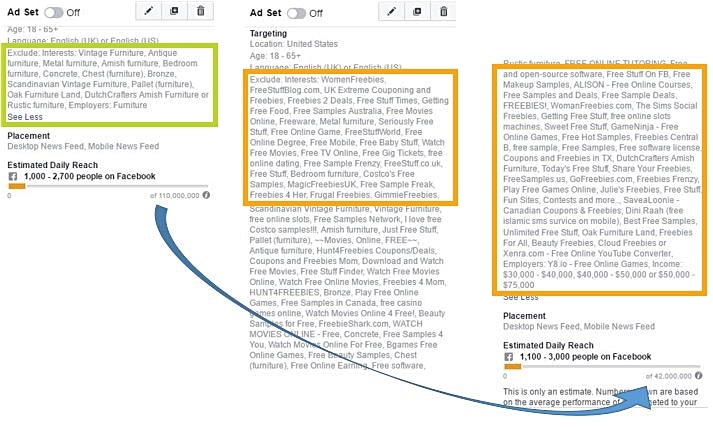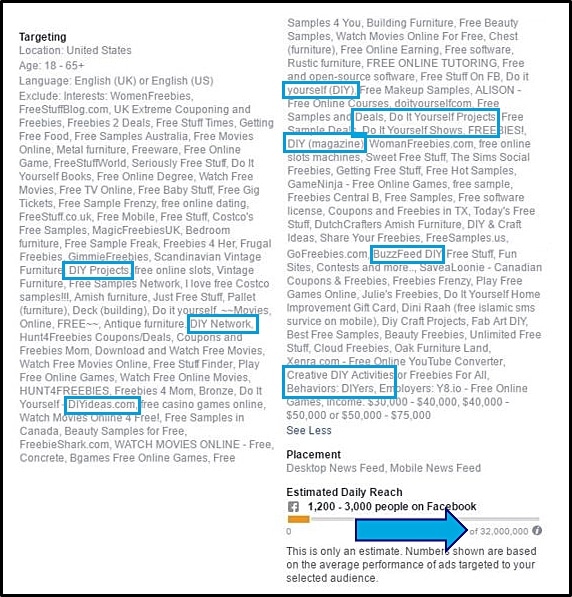Negative keywords are BUTTER to search marketers’ bread. Excluding irrelevant and information-only queries from search campaigns helps performance marketers focus the audience and preserve precious PPC budgets, making keyword exclusions a highly valued targeting feature.
Smart social marketers are using the same negative keyword logic from search and mapping to social campaign, however this tactic requires a mindshift. In social campaign targeting, we’re not excluding terms we’re excluding personas. It’s radically different and can’t just be copy+pasted from search.
Why?
Simply copy+pasting keyword lists or negative keyword lists won’t result in effective targeting. It’s just not the same. Search PPC keywords are direct (or partial) queries users search whereas social targeting is all about who the person IS. It is knowing what they like, follow, buy, have affinity/loyalty, or demonstrate behaviors that match the audience most likely to buy what’s being advertised.
It’s a social marketer’s duty to review the negative keywords from search campaigns and extrapolate the personas of users who would search with those queries. Let’s review a negative keyword list for a quality (re: expensive) furniture manufacturer and break it down into personas we can exclude in Facebook’s targeting.
Mapping Negative Search PPC Keywords to Social
Granted most marketers start targeting with basic demographics and interests of the people they want to reach. However, starting the audience with exclusion psychographics gleaned from search illustrates just how powerful the negative keywords can be.
Analyzing negative keywords with a PPC campaign can reveal trends, themes… true PSYCHOGRAPHICS that social marketers can extract insight from to carry over to paid social campaigns.
Above, the psychographic themes are apparent once the similarly shaded fields are reviewed. From search ppc negative keyword lists, social marketers would exclude: cheapskates (orange), DIYers or information-seeking users (blue), and users who have an affinity for styles or materials this manufacturer doesn’t produce (green).
First up on the cutting block are the materials or products that don’t apply. In this case, users with a pension for products made of woods, concrete, or vintage and antique styles are added as exclusion targeting in Facebook, which eliminates 10 million users.
View users querying “discount terms” through the psychographic lens; these folks are looking for a DEAL. They are frugal and money conscious. They probably don’t have much discretionary income, presumably like to get things for free, and are likely couponers. Since our product is higher-end, exclude lower income brackets and the famous Facebook interests “freebie interest”.
Next, axe those crafty DIYers looking for the next great thing to build and pin a badge on their sash, vest or Pinterest board, proudly proclaiming, “Look what I built!” They are out there searching for patio furniture plans to build or rehab ” to save ad dollars and skip irrelevant impressions, get ’em outta your targeting too. We appreciate their ambition, but they’re not our market.
Finally, add interests that include patio furniture, garden furniture, picnic tables, and other outdoor furniture affinities to nail your final audience.
Excluding the Present Participle – The KING of Verbs
Marketers and users at large still describe actions they take with verbs in the present participle ” those ending with “ing.” Action words. Social has a notorious rep’ for being the place where users express what they are doing, however banal, in the moment. Targeting, or in this case excluding, words that use the present participle is MONEY (saving). The context or words chosen to query can also significantly indicate intent. For example, a user searching “brain surgery” is looking for something vastly different than the user searching for “brain surgeon” or, more specifically, “brain surgeon [city].” It’s the difference between doing a report for seventh-grade biology class and finding the gifted hands that could save a life, the searcher’s life.
Let’s say you are a tasty takeout and delivery restaurant looking for homebodies who just want dinner to magically show up at the door or those who want to quickly grab some grub and get the heck home to resume their latest Netflix binge. Marketers can make a meal of those users who have expressed interests in “eating out” or “going out to dinner.” etc. Do a little bit of keyword stemming and see how effective moving negative keywords from the Search PPC campaign helps social marketers zero in on users who prefer to eat at home with bae.
Before we even start determining who the audience IS, it’s been chopped in half by excluding those who aren’t within the psychographic target. They AREN’T into dining out or cooking for themselves.
The PPC negative keyword list should also include types of food not on the establishment’s take-out menu. A company that sells delicious Asian fare would want to exclude fast food chains and all those other “-ans” out there (German, Italian, Indian, Mexican, Lithuanian; you get the picture) while including users who indicate they enjoy take-out and online food ordering.
Finally, take this targeting home and hone-in on the geo, or in the case, the neighborhood the business serves.
To wrap up, can you use PPC negative keywords as keyword exclusions in Facebook? Not in the copy+paste temptress fashion one might hope for. However, by organizing search PPC negative keywords into categories, psychographic personas come into view. Yes, you can map search to social and narrow in on killer social targeting birthed from search negative keywords.
Happy targeting. 🙂


















